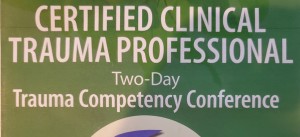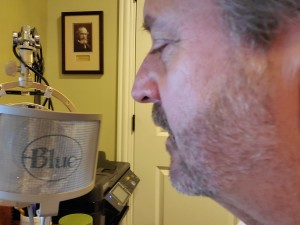 Have you heard of the “Baader-Meinhof” effect? If not, I’m positive you’ll soon be seeing evidence of it everywhere.
Have you heard of the “Baader-Meinhof” effect? If not, I’m positive you’ll soon be seeing evidence of it everywhere.
That’s what “it” is, by the way — that curious experience of seeing something you’ve just noticed, been told of, or thought about, cropping up all around you. So …
You buy a car and suddenly it’s everywhere. That outfit you thought was so unique? Boom! Everyone is sporting it. How about the conversation you just had with your friend? You know, the one that was so stimulating and interesting? Now the subject is on everyone’s lips.
Depending on your level of self-esteem or degree of narcissism, Baader-Meinhof either leaves you feeling on the “cutting edge” of cultural trends or constantly lagging behind others. For me, it’s generally the latter. And recently, its a feeling that has been dogging me a fair bit.
The subject? Trauma.
Whether simple or complex, ongoing or one-off, experienced as a child or adult, trauma is the topic de jour — a cause célèbre linked to an ever-growing list of problems, including depression, anxiety, dissociation, insomnia, headaches, stomachaches, asthma, stroke, diabetes, and most recently, ADHD.
ever-growing list of problems, including depression, anxiety, dissociation, insomnia, headaches, stomachaches, asthma, stroke, diabetes, and most recently, ADHD.
Then, of course, there are the offers for training. Is it just me or is trauma the subject of every other email solicitation, podcast announcement, and printed flyer?
The truth is our field has been here many times before. Over the last 25 years, depression, multiple personality disorder, rapid cycling bipolar disorder II, attention deficit disorder, and borderline personality disorder have all burst on the scene, enjoyed a period of intense professional interest, and then receded into the background.
Available evidence makes clear this pattern — aha, whoa, and hmm what’s next? — is far from benign. While identifying who is suffering and why is an important and noble endeavor, outcomes of mental healthcare have not improved over the last 40 years. What’s more, no evidence exists that training in treatment modalities specific to any particular diagnosis — the popularly-termed, “evidence-based” practices — improves effectiveness. Problematically, studies do show undergoing such training increases practitioner perception of enhanced competence (Neimeyer, Taylor, & Cox, 2012) .
 On more than one occasion, I’ve witnessed advocates of particular treatment methods claim it’s unethical for a therapist to work with people who’ve experienced a trauma if they haven’t been trained in a specific “trauma-focused” approach. It’s a curious statement — one which, given the evidence, can only be meant to bully and shame practitioners into going along with the crowd. Data on the subject are clear and date back over a decade (1, 2, 3). In case of any doubt, a brand new review of the research, published in the journal Psychotherapy, concludes, “There are no clinically meaningful differences between … treatment methods for trauma … [including those] designed intentionally to omit components [believed essential to] effective treatments (viz., exposure, cognitive restructuring, and focus on trauma)” (p. 393).
On more than one occasion, I’ve witnessed advocates of particular treatment methods claim it’s unethical for a therapist to work with people who’ve experienced a trauma if they haven’t been trained in a specific “trauma-focused” approach. It’s a curious statement — one which, given the evidence, can only be meant to bully and shame practitioners into going along with the crowd. Data on the subject are clear and date back over a decade (1, 2, 3). In case of any doubt, a brand new review of the research, published in the journal Psychotherapy, concludes, “There are no clinically meaningful differences between … treatment methods for trauma … [including those] designed intentionally to omit components [believed essential to] effective treatments (viz., exposure, cognitive restructuring, and focus on trauma)” (p. 393).
If you find the results reported in the preceding paragraph confusing or unbelievable, recalling the “Baader-Meinhof” effect can be help. It reminds us that despite its current popularity in professional discourse, trauma and its treatment is nothing new. Truth is, therapists have always been helping those who’ve suffered its effects. More, while the field’s outcomes have not improved over time, studies of real world practitioners show they generally achieve results on par with those obtained in studies of so-called evidence-based treatments 1, 2, 3).
Of course, none of the foregoing means nothing can be done to improve our effectiveness. As my Swedish grandmother Stena used to say, “The room for improvement is the biggest one in our house!” 
To get started, or fine tune your professional development efforts, listen in to an interview I did recently with Elizabeth Irias from Clearly Clinical (an approved provider of CEU’s for APA, NBCC, NAADAC, CCAPP, and CAMFT). Available here: What Every Therapist Needs To Know: Lessons From The Research, Ep. 61.
In it, I lay out several, concrete, evidence-based steps, practitioners can take to improve their therapeutic effectiveness. It’s FREE, plus you can earn a FREE hour of CE credit. Additionally, if follow them on Instagram and leave a comment on this post, you’ll be automatically entered into a contest for one year of free, unlimited continuing education — the winner to be announced on October 31st, 2019.
Until next time,
Scott
Scott D. Miller, Ph.D.
Director, International Center for Clinical Excellence


–

I guess I’m a narcissist with low self esteem. Great post, I’m far more aware of this trauma malarkey than I was of the CBT nonsense;). And I don’t like it,
So glad to see this post. There is no evidence of a direct relationship between trauma and psychopathology. People respond along the bell shaped curve, with just as many (if not more) experiencing post traumatic growth as PTSD,. Yet, the field continues to talk about treating trauma. This is bizarre. We can’t treat “trauma” or turn back the hands of time. What happened, happened. All we can do – which is a lot- is help patients experience and integrate their feelings about what happened, as well as attending to what they have made it mean.
What is the citation for the quote out of Psychotherapy? I didn’t see it anywhere.
Thanks,
Dr Patricia Coughlin
Thought-provoking post. Thanks! The idea that it is ” unethical for a therapist to work with people who’ve experienced a trauma if they haven’t been trained in a specific “trauma-focused” approach” bugs the hell out of me. And I think it is hugely counter-productive.
Even so, I am still open to the possibility that some of the new strategies based on polyvagal theory, somatic experiencing, etc. may have – MAY have – taken us into undiscovered realms of effectiveness in treating folks who have been traumatized.
Peace!
Great post, as always!
I often have to “check myself” and step back from the finely tuned marketing powerhouses of some of these approaches. Great reminder of what’s at play psychologically for us as practitioners. Similar to you Scott, I tend to be more susceptible to the “lagger” mentality!
I’m a Clinical Psychologist and I’ve beed trained in Psychotraumatology, I can say that I observed this “trend” to “see” or to “dig” for trauma. I know that not specifically the method / approach matters, but the therapeutic alliance and the personality of the therapist. And as you said, of course, trauma was there long before any “psychotraumatologist” ever.
*I forgot to mention that this “trend” was through the majority of my colleagues. Like there was nothing but trauma. And we can easily understand the link between this attitude and the confirmation bias.
Thanks, Scott, for another great article and reminder that there are many “right” ways to work with any given client. S
BTW – I keep forgetting to mention that your website and this blog along with your books and trainings continue to be invaluable to those of us in the field who are teaching, training, and mentoring other clinicians.
Yours is one of the places I often refer new clinicians to when they are confused about best practices and evidence-based work in our field.
Thank you for continuing your work and sharing it so generously with us!
Always good to read your posts, and they are always creative. Very pleased.
I’m so relieved to hear (read) Scott Miller say that he believes he tends to be on the
back end of the latest fad. I was really feeling left out, hearing all of my colleagues gushing about their training regarding trauma therapy, while I missed all of the workshops that were presented in my part of the country.
Thanks, Scott, for some evidenced based insight into what is actually productive in the journey of learning how to be a helpful therapist!
Scott,
I saw you in San Francisco in December. Thank you for sharing your knowledge and insights. So helpful!
As usual, I appreciate the wit and flair of your writing while you elucidate the actual research and facts of our field. I wish more colleagues and my college would take this seriously. After many years of clinical work and using the outcome measures, I am a believer and also tired of having to get more CEU’s to keep “proving efficacy”. Thank you for continuing to bring forth the data in creative, accessible and timely ways!
This is in the least dismissive, at the worst dangerous. Certainly the prevalence of trauma information is overdone and flimsy in many instances such as short competency courses. However, trauma and particularly complex trauma create changes that are useful to understand, even if merely to attune to your client with positive regard. In an industry saturated with cognitive solutions, it’s so important to know in the case of trauma the body does indeed ‘keep score’. For a trauma survivor, a bottom up approach, rather than the top down industry standard, can be the greatest saving grace. This I know both personally and professionally.
Thank you. I am forwarding to my colleagues the link to your conversation with Ms. Irias. I regularly engage in peer supervision and supervision with a mentor. An EAP I work with collects outcome data and that has been helpful in my work. You have inspired to collect outcome data with my other clients.
Research has consistently shown that it is the therapist-client relationship (or the alliance or just the therapist) that is associated with the most effective change. Yet, those who are firmly convinced of this have yet to explain how that happens.
The best that Norcross and Wampold (2019) (referred to by Scott) could do was to conclude that “the (therapist-client) relationship serves as the curative foundation of effective psychotherapy for trauma,” and “the relationship is the heart of healing trauma [as] relational damage is the core of trauma.” (p. 393). If one includes “little ts” and “big Ts,” that covers most of the problems presented for therapy.
While the Norcross-Wampold summary of therapy for trauma was described in quite a captivating way, their discussion may have the effect of moving the Baader-Meinhof Effect to the Baader-Meinhof Syndrome. The great unanswered question(s) remain unanswered. That is, what makes the most effective therapists so effective; or, why outcomes have remained stagnant for the last forty years.
Thanks to a client of mine who asked for multiple-hour sessions for several days a week in hopes of a breakthrough (which happened at the end of the second week), and during which I had the unheard of luxury of not having to worry about time, I was able to resist all urges that I “had to do something.” Instead, I just supported that person’s experiencing as best I could.
In doing so, I repeatedly observed the following: SUFFICIENT SUPPORT FOR THE CLIENT’S EXPERIENCING; i.e., the explicit and implicit dimensions, with the latter as by far the most important as that is where not-yet-verbalized hurtful experiences have been held in “cold storage” start to unfreeze, is my offering of the key to the great unanswered question(s).
I also discovered that this kind of support is profound in its simplicity as it requires the most exacting attention and patience. The essential element here, which took me some years to formulate, is that the therapist should not distract clients from their sense of their own experiencing. We know what that’s like in ordinary conversation. For clients, its really quite upsetting (See fascinating research bv David Rennie).
When the client’s nervous system has “decided” it has received enough support, the client will get “emotional.” That is fine. It has occurred in an unforced/unprovoked way. It is NOT retraumatizing. It’s what I’ve termed therapeutic catharsis. If interested, check out PsycINFO, or ResearchGate, two of my articles on their website.
Sufficient support for the client’s experiencing may be why FIT is so effective. It invites the client to “speak” to the therapist.
Well written and I want to win the competition
Very interesting perspective!
This was very informative and helpful. The need for trauma therapy is an ever growing need. I am new to your blog, but am learning so much and look forward to learning more from a different perspective.
It still amazes me that FIT isn’t considered best practice in our profession. It has helped me and my clients immensely. Keep doing the great work you do Scott!
The benefit for me to pay attention to the lastest therapeutic fad is that at least it is on my radar for a while and might not otherwise made it into my tool bag. It neither serves me nor my clients if I become comfortable or complacent in my educational pursuits.
I bought into the trauma training need story. Took training in CPT, PE & EMDR to improve my practice.
Some good reminders in this post. Although I believe ongoing education, as with ongoing measurement of one’s work, keeps us fresh.
Really interesting article; thank you for sharing. I’ve noticed that standard talk therapy is now met with cringes by specially-trained trauma EBP colleagues, as if the gold standard has now failed us… that’s simply not the case.
Interesting comparison- I enjoy your posts. These fad treatments have their limitations. Also, I started following Clearly Clinical on Instagram. I liked the CEU podcast.
Very interesting! I was just introduced to your website and followed your Instagram. I look forward to reading more from you. Thanks for sharing!
I loved the podcast! thank you so much for doing it. I have also followed them on Instagram.
I was referred here from Clearly Clinical. I appreciate having the additional resource that you are offering. Thank you!